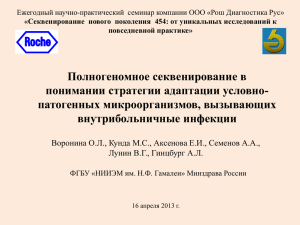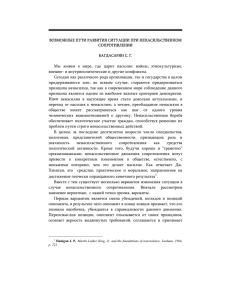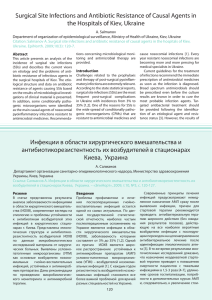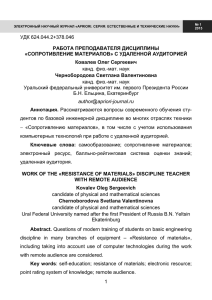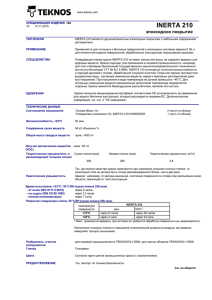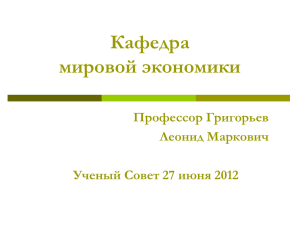Программа WHONET
advertisement

ГБОУ ВПО НижГМА Минздрава России Программное обеспечение микробиологического мониторинга в медицинских организациях. Возможности программы WHONET Саперкин Н.В., к.м.н., доцент кафедры эпидемиологии, заведующий организационно-методическим отделом НИИ профилактической медицины НижГМА Саранск, 2014 Распространение программы WHONET в мире Программа WHONET Разработчик: World Health Organization – Всемирная Организация Здравоохранения система управления базами данных; предназначена для обработки результатов исследований чувствительности микроорганизмов к антимикробным препаратам; используется как в повседневной, так и научной практике. Аналитические возможности программы Анализ деятельности микробиологической лаборатории: количество исследований, виды исследуемого материала, распределение по отделениям; Оценка микробиологического мониторинга – в целом, в динамике, по возбудителям, по отделениям; Оценка антибиотикорезистентности – в динамике, по антибиотикам, по микроорганизмам; Подбор антимикробных препаратов; Выявление штаммов с одинаковыми профилями резистентности; Контроль качества при лабораторных исследованиях; Изучение эпидемиологии резистентных штаммов. Компоненты WHONET Настройка программы Ввод данных Анализ данных Начальное окно WHONET Основное окно WHONET Настройка лаборатории 6 Настройка лаборатории: Антибиотики Наборы (панели) антибиотиков Настройка: Местонахождение больного Ввод данных Создаём новый файл: Способы ввода данных в программу количественные результаты!!! (например, 13 мм, 64 мг/мл) качественные результаты (R = резистентный, I = промежуточный, S = чувствительный) Клинический отчет Анализ данных Создание сводок данных (line listing) % резистентных и чувствительных культур Анализ одновременно по нескольким файлам Графики рассеивания (скаттерграммы) Профили резистентности BacTrack – оценка тревожных сигналов о штамме или группе штаммов Выбор конкретных микроорганизмов для анализа Анализ: Построчный перечень и сводка Ежедневный обзор перечня всех культур специалистами по эпиднадзору. Еженедельный или ежемесячный обзор перечня всех больных с грам-отрицательными микроорганизмами в посеве крови. Еженедельный или ежемесячный обзор перечня всех больных со штаммами, высеянными из суставов и т.п. Еженедельный или ежемесячный обзор перечня всех больных с MRSA, MRSE. Ежемесячная сводка по выделенным организмам может помочь установить вспышку внутрибольничной инфекции. Выводы по локализации и распространению выделенных MRSA могут предположительно указать на проблемную сферу. Пример сводки по культурам: часть 1 Пример сводки по культурам: часть 2 Секторная диаграмма Структура микрофлоры, полученной из отделяемого ран, % 5 9 3 30% 18 7 28% E. faecalis E. faecium E. coli S. aureus S. epidermidis S. saprophyticus P. aeruginosa абсолютные значения Пример подсчёта % чувствительных штаммов Соотношение чувствительных и резистентных к антибиотикам штаммов E. coli за определенный период времени Анализ: Профили резистентности Анализ: Гистограммы Анализ: Графики рассеивания Сравнение двух разных тестов WHONET в практической деятельности Application of WHONET in the Antimicrobial Resistance Surveillance of Uropathogens: A First User Experience from Nepal // Ghosh AN [et al]. – 2013. – №7(5). – P. 845-848. “Out of the 3209 specimens, 497 bacterial isolates were obtained … Escherichia coli (66.2%) was the commonest bacterial isolate…Among the gram-negative enteric bacilli, a high prevalence of resistance was observed against ampicillin and ciprofloxacin”. Automated use of WHONET and SaTScan to detect outbreaks of Shigella spp. using antimicrobial resistance phenotypes // Stelling J. [et al]. – 2010. – №138(6). – P. 873-883. “Electronic laboratory-based disease surveillance incorporating statistical cluster detection methods can enhance infectious disease outbreak detection and response”. Application of WHONET for the surveillance of antimicrobial resistance // Sharma A, Grover P.S. – 2004. – №22(2). – P. 115-118. “antimicrobial sensitivity of 4,289 bacterial isolates…Drug resistance was high in most of the isolates. It was maximum (80-94%) for ampicillin, nalidixic acid and cotrimoxazole”. Antimicrobial resistance in gram negative bacteria isolated from intensive care units of Colombian hospitals, WHONET 2003, 2004 and 2005 // [Article in Spanish] Miranda M.C. [et al]. – 2006. – №26(3). – P. 423-433. “The susceptibility tests were performed by automated methods in 9 hospitals…The high resistance rates reported especially for A. baumannii, evidenced the presence of multidrug resistant bacteria in both ICUs and wards at every studied institution”. Analysis of antimicrobial drug resistance of Staphylococcus aureus strains by WHONET 5: microbiology laboratory database software // Mochizuki T. [et al]. – 2004. – №71(5). – P. 345-351. “The data of 2,113 Staphylococcus aureus strains were accumulated and analyzed. Overall Oxacillin resistance ratio in our hospital was 65.7%. The ward of the smallest Oxacillin resistance ratio was Pediatrics/Ophthalmology ward”. Monitoring antibiotic resistance in Argentina. The WHONET program, 1995-1996 // Rossi A. [et al]. – 1999. – №6(4). – P. 234-241. “In Argentina the program was developed through a network of 23 public and private hospitals that participate in national and international quality-control programs… the antimicrobial susceptibility of 16,073 consecutive clinical isolates was determined … More than half of the Escherichia coli urinary isolates were resistant to ampicillin and more than 30% to trimethoprim/sulfamethoxazole”. In vitro activity of trovafloxacin, of other fluoroquinolones and of related antimicrobials against clinical isolates. Grupo colaborativo WHONET-Argentina // Rossi A. [et al]. – 1999. – №59. – Suppl 1. – P. 8-16. “The in vitro activity of trovafloxacin…against 5671 clinical isolates recovered by representative institutions of different provinces in our country. The resistance percentage to gentamicin and third generation cephalosporins among enterobacteriaceae was high: 17% and 16% respectively, with a considerable variation according to the analyzed species. The resistance to ciprofloxacin and TRV affected approximately 9% of the isolates…”. Surveillance of antimicrobial resistance: the WHONET program // Stelling J.M., O’Brien T.F. – 1997. – №24. – Suppl 1. – P. S157-158. “Genes expressing resistance to each antimicrobial agent emerged after each agent became widely used. More than a hundred such genes now spread selectively through global networks of populations of bacteria in humans or animals treated with those agents. Information to monitor and manage this spread exists in the susceptibility test results of tens of thousands of laboratories around the world. The comparability of those results is uncertain, however, and their storage in paper files or in computer files with diverse codes and formats has made them inaccessible for analysis. ”. WHONET: removing obstacles to the full use of information about antimicrobial resistance // O’Brien T.F., Stelling J.M. – 1996. – №25(4). – P. 162-168. “WHONET is an information system developed to support The World Health Organization’s goal of global surveillance of bacterial resistance to antimicrobial agents.”. Survey of the levels of antimicrobial resistance in Argentina: WHONET program-1991 to 1994 // Rossi M.A. [et al]. – 1995. – №6(2). – P. 103-110. “Argentina joined WHONET program in 1989. Five hospitals from Buenos Aires are taking part…the low level of susceptibility to aminopenicillins, cephalosporins and aminoglycosides is remarkable”. WHONET: an information system for monitoring antimicrobial resistance // O’Brien T.F., Stelling J.M. – 1995. – №1(2). – P. 66. Благодарю за внимание!
